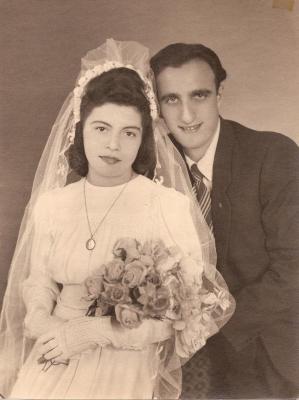Identifer: CJF-2014203
Medium
-
Description
These photographs and items are primarily from the time Josef & Freda Bienenfeld spent in the Displaced Persons (“DP”) Camp in Lampertheim, Germany, approximately 1946 – 1949.
These items were provided to us courtesy of Dr. David G. Bienenfeld of Cincinnati, Ohio, who is the son of Josef & Freda Bienenfeld
Lampertheim DP camp was located in a small town on the bank of Rhine in the Frankfurt District of the American occupational zone. It operated between the end of 1945 and May 1949 and housed 1200 Jewish DPs, mainly from Poland. In comparison with other camps, the DP inhabitants of Lampertheim were relatively well-off.
US army Captain Alvin Corwin was the commander of the Camp. When the initial DPs were sent to the city of Lampertheim, Captain Corwin described them as a population of "walking skeletons." The local Germans objected to the Jewish DPs presence in their city. Captain Corwin had to threaten the uncooperative Germans with anti-aircraft guns in order to create a community for the displaced persons. Under Captain Corwin's guidance, Lampertheim became one of the model D.P. camps, receiving a commendation from Eleanor Roosevelt.
The Jewish DPs lived in requisitioned private houses in the village (This led to a lot of hostility against the DPs). The camp organized its own civic administration, with thirty unarmed policemen and uniformed fire service. Initially, armed German police were in the camp, however this resulted in violence as the Jewish DPs resented the fact that the American military authorities were using armed German police in the camp. However, US Army officials claimed that the German police are needed to suppress black market operations.
In February of 1942, the Lampertheim camp was declared out of bounds for German police. In addition, “orientation classes” were opened for newly-arrived American troops stationed at the camp, in order to educate the soldiers as to the rights of the displaced persons.
The camp also had a post office which operated as a tracing bureau for missing relatives of the camp’s community. The health center in the camp was operated by doctors, who were at the same time DPs and residents of the center.
The camp had a strong orthodox Jewish community and maintained a developed religious life, with a synagogue located in a converted private house, kosher kitchen for ninety DPs and a Talmud Torah Hebrew school. There was also a Hebrew library, culture house, a theatre group and a small orchestra. The camp also ran a secular elementary school and a kindergarten. A summer camp was organized for the children during the holidays. A few kilometers from the town, the camp operated a kibbutz for thirty young people training in farming in preparation for their emigration to Palestine. There was an ORT school, which had ninety-seven students, most of whom attended a course in dressmaking and worked in the modern clothes repairing workshop organized in the camp.



Leave a Comment